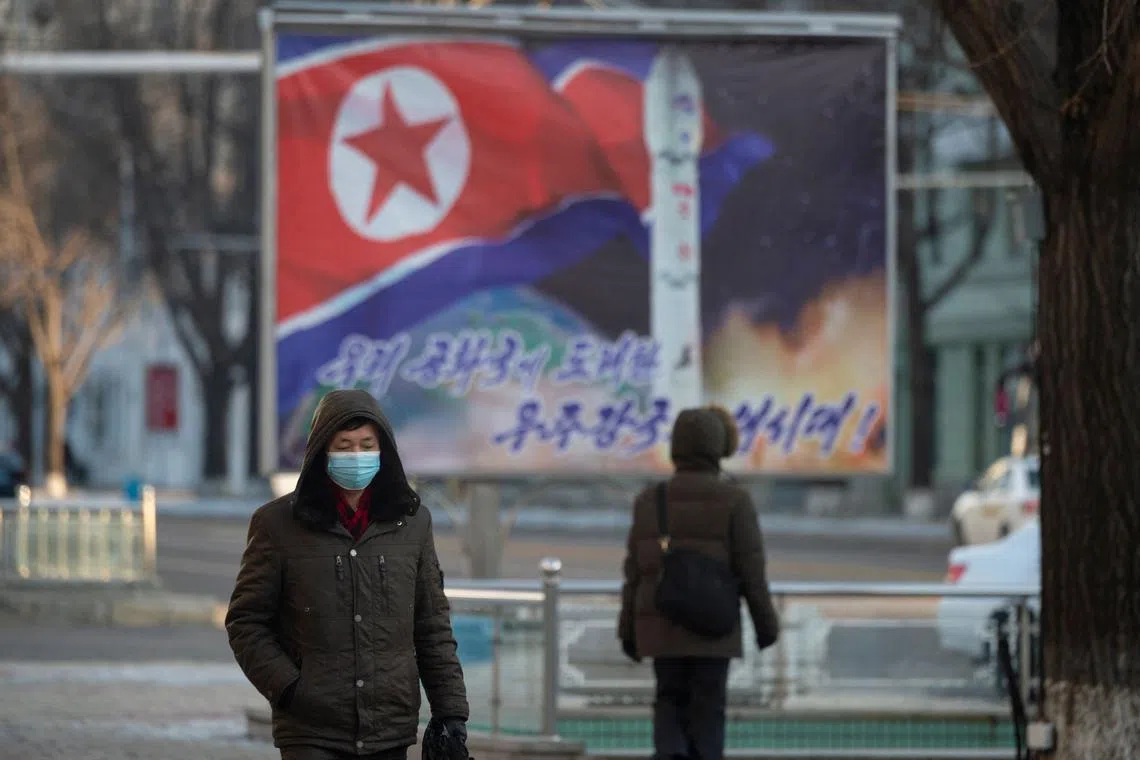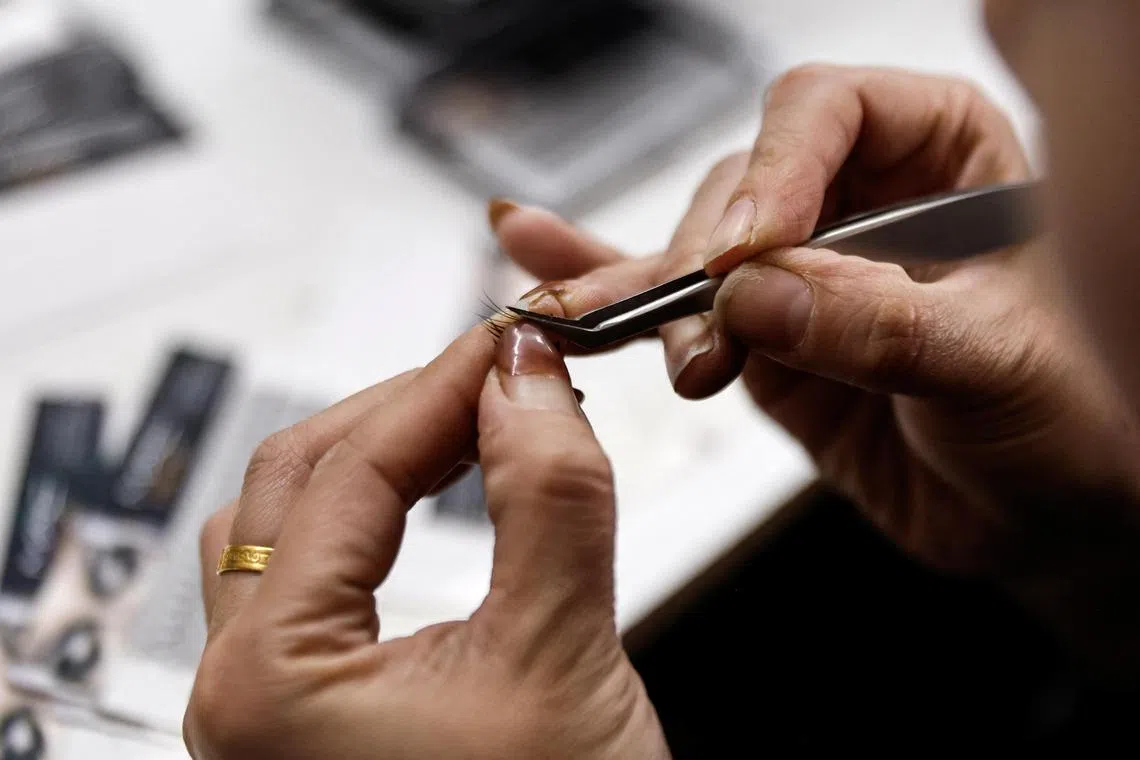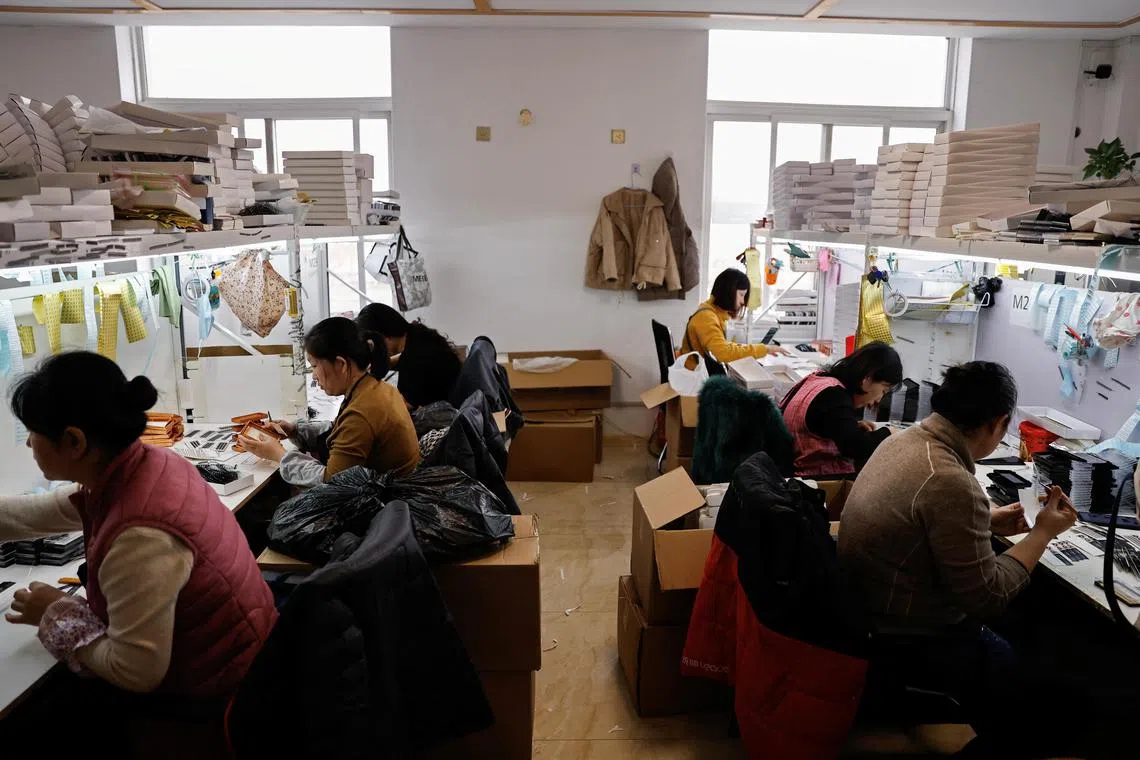Barred from exporting clothes, Pyongyang cashes in on fake hair, eyelashes
Sign up now: Get insights on Asia's fast-moving developments

A production line manufacturing false eyelashes at a workshop in Monsheery, Pingdu, Shandong province, China, on Nov 16, 2023.
PHOTO: REUTERS
Follow topic:
SEOUL - North Korea may be known for making weapons of mass destruction, but its biggest exports are a lot more innocuous – and even flimsy.
False eyelashes and wigs now make up the lion’s share of its exports to neighbour China, which is by far North Korea’s largest trading partner.
These items made up nearly 60 per cent of North Korea’s annual exports totalling US$292 million (S$392 million) to China in 2023, according to data from China’s General Administration of Customs released on Jan 22.
The export value of these beauty products spiked by more than 13 times from 2022 to US$163 million in 2023, as Pyongyang started relaxing Covid-19 border restrictions and resumed trade with China.
The figure is also three times that of 2019, before the pandemic.
The sudden boom in demand for these products, which North Korea has been making for more than 10 years, is likely due to them being among the rare items not sanctioned by the United Nations, said Professor Mimura Mitsuhiro of the University of Niigata Prefecture’s Economic and Social Research Institute for Northeast Asia.
Such a boom is unusual, he said, adding that North Korea had no choice but to substitute the export of clothes with that of wigs and eyelashes, so as to maintain its foreign currency income and employment rates.
“Up to 2016, there was a lot of export of clothes from North Korea to China. But under the UN sanctions, it can no longer export that. So the workers who made the clothes in North Korea all lost their jobs.”
Textiles were North Korea’s second-biggest export after coal and other minerals in 2016, totalling US$752 million.
Under tightened UN sanctions imposed on North Korea in 2016 and 2017 for its nuclear and missile tests, Pyongyang is barred from exporting its biggest money-makers – coal, iron, seafood and textiles.
While the country is not exactly starving, it is in “a very bad economic depression”, said Prof Mimura, who has visited North Korea some 40 times for academic exchanges.
Most people there have only two meals a day, he added.

A worker works on a production line manufacturing false eyelashes at a workshop of Monsheery, in Pingdu, Shandong province, China on Nov 16, 2023.
PHOTO: REUTERS
North Korea, with its population of about 26 million, desperately needs foreign currency to buy oil and staples to support its people, he said.
“There is inflation and because foreign currency income is getting lower and lower, it hurts their purchasing power. Yet they cannot increase the price of staples like rice or corn. So their economy is very bad currently.”
While party members and certain government officials receive rations from the government, ordinary citizens do not.

North Korea, with its population of about 26 million, desperately needs foreign currency to buy oil and staples to support its people.
PHOTO: AFP
According to the White Paper on Human Rights in North Korea 2022 released by the Korea Institute for National Unification in 2023, wig-weaving is a popular side job for North Korean high school students hoping to help put food on the table.
The teenagers have good eyesight, which allows them to weave wigs under oil lamps in an electricity-scarce country.
Quoting a defector to South Korea in 2021, the White Paper said that one wig takes four to five hours to make and can fetch as much as 12kg of rice.
Online North Korean news website Daily NK reported last November that many market vendors at Sinuiju, which borders the Chinese city of Dandong, are ditching their day jobs for wig-making as it was far more lucrative.
While most of the hair for making wigs and eyelashes is imported from China, the demand for more raw hair material has led to North Korean state enterprises offering 20kg to 25kg of corn for 25cm bundles of hair.

The production of false eyelashes and wigs is said to be highly labour-intensive. Those stitched by hand fetch higher prices as they are considered high in quality.
PHOTO: REUTERS
According to the White Paper, there are wig and fake eyelash-making departments at labour correction camps, where mostly female prisoners perform the task without receiving any wages.
The production of false eyelashes and wigs is said to be highly labour-intensive, with wigs that are crocheted and stitched by hand fetching higher prices as they are considered high in quality.
False eyelashes from North Korea are considered to be of “high-quality craftsmanship” as each lash is individually sharpened to the millimetre and attached one by one, a Qingdao eyelash factory owner told China’s online Jiemian News.
Qingdao, on the eastern Chinese coast, is said to be home to China’s largest eyelash production. The city is estimated to hold a 70 per cent share of the global market and imports 80 per cent of its products from North Korea.
While the labour cost for processing a high-end wig in China is 1,000 yuan (S$189), the cost of a North Korean-produced one can be as little as 300 yuan.
On China’s popular online wholesale market platform Alibaba 1688, North Korea-produced fake eyelashes, which can be customised to “European and American standards”, go from 15 yuan per set, while wigs with “North Korean craftsmanship” fetch about 350 yuan.
It makes sense for China, the world’s leading exporter of wigs and fake eyelashes, to outsource the processing to North Korea given that this is a low-margin business, said Dr Troy Stangarone, senior director and fellow at the Korea Economic Institute of America, a think-tank based in Washington.
“What we are likely seeing is that China and North Korea are looking for areas that aren’t sanctioned, where they can do processing work or partial assembly in North Korea to try and reduce costs for Chinese firms,” he said.
Wages in China have been going up in recent years and it is not necessarily “one of the world’s cheapest producers”, he added.
This means that your “made-in-China” wigs or fake eyelashes could have come from North Korea.
In 2019, US cosmetics company e.l.f. Beauty was fined US$1 million after an internal audit discovered that some of their false eyelash kits imported from China had contained materials sourced from North Korea.
Dr Stangarone explained that while the products are not under UN sanctions, the United States has a separate set of sanctions which prohibits the importation of any goods from North Korea to the US.
He believes that trade between China and North Korea will continue to grow in 2024, but it would be wise for Pyongyang to rebuild other legitimate export categories to avoid being overly reliant on wigs and fake eyelashes.

It makes sense for China, the world’s leading exporter of wigs and fake eyelashes, to outsource the processing to North Korea given that this is a low-margin business.
PHOTO: REUTERS
China has traditionally accounted for more than 90 per cent of North Korea’s exports.
One possible industry he said would be watch movements, referring to assembly of the parts that go into the mechanisms of a watch that allow the watch hands to move.
He noted that the making of these watch components and fake hair is labour-intensive.
In the long run, not only the North Korean regime but also its population would benefit from the development of “more industries that will allow for a greater amount of employment”, he added.


